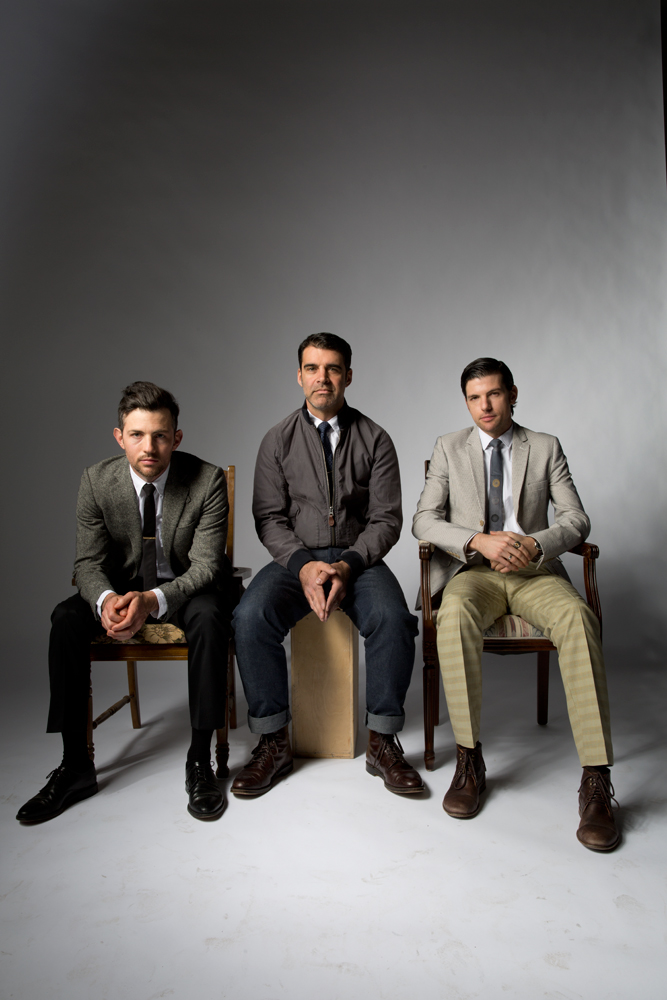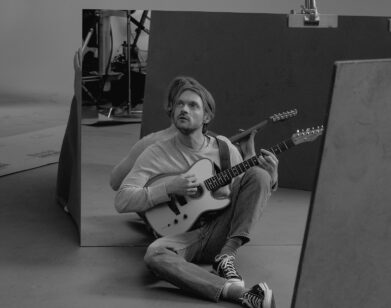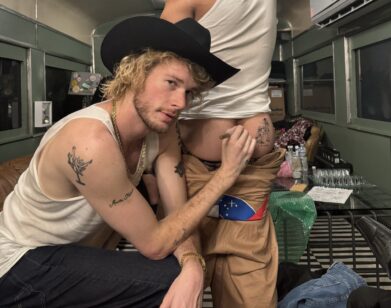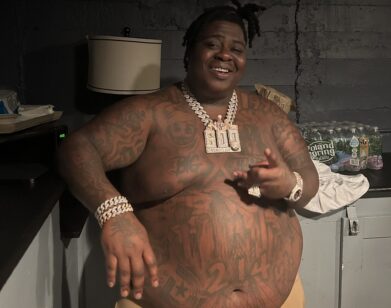The Other Side of the Avett Brothers

ABOVE: THE AVETT BROTHERS. PHOTO COURTESY OF CRACKERFARM.
Straddling the lines between classic rock, bluegrass, and pop-leaning folk, The Avett Brothers’ discography constantly evolves. Out tomorrow, the band’s ninth full-length, True Sadness, encompasses each of these musical genres with themes such as self-improvement and the loss of love resonating throughout. On the album opener, foot-stomping track “Ain’t No Man,” Seth and Scott Avett hone in on self empowerment, singing, “You say you look funny, I say you’re a star / I say you’re whatever you think you are.” While on a slower acoustic track like “Fisher Road to Hollywood,” the brothers, alongside bandmates Bob Crawford and Joe Kwon, focus on the journey of leaving friendships left behind, yet still returning to old habits (“I am staying here with you / I’ve done all I know to do”). In addition to their honest lyricism, fueled by emotional experiences within the last three years, the album shows the band embracing synthesizers (“Satan Pulls the Strings”) and full orchestral elements (“May It Last”). As a whole, True Sadness is the band’s most intimate and exploratory album to date.
More than music, however, both brothers also create visual art. Having grown in up in Concord, North Carolina, Scott, now 39, attended East Carolina University, and Seth, now 35, attended UNCC, where they each received formal art training. “The vibe in art schools is a capsule, there’s an incubator for all types of creativity,” Scott says. “Music flowed through the studios in East Carolina University and through UNCC. We practiced there, we wrote there, we made imagery there,” he continues. “That’s why you don’t see photographs of us on our albums. We always want to make the artwork.”
Though it might not be known to many fans, visual art continues to play an instrumental role in the brothers’ lives. When Scott connected to his friend, the artist Eric Fischl, for a conversation about the album and overlapping art forms, Seth was “in the back of the bus, drawing feverishly.”
ERIC FISCHL: Hey Scott, where are you?
SCOTT AVETT: Hey, Eric. We are in Deadwood, South Dakota. The day before yesterday, we went to Washington, D.C. to bury our grandmother, who was a general’s wife in Arlington, and flew back last night to Minneapolis and drove through the night to South Dakota. We play tonight.
FISCHL: That’s quite a journey. I’m sorry about your grandma. You told me she passed away in December …
AVETT: She did. She passed away a month before her 95th birthday.
FISCHL: Probably not a world record but a personal best for sure, right?
AVETT: I’d say. [laughs]
FISCHL: So I got your new album and I’ve been listening to it for the last two days. There are so many songs in it that have an old-for-your-age type of feel; they’re philosophical and projections of long lives lived together. I found it very poignant and moving. Are you and Seth doing the writing?
AVETT: Absolutely. Seth and I were all hands on deck for all the lyrics, and all the melodies as well.
FISCHL: I’ve never collaborated in equal parts. I’ve worked with craftsmen to make a print or sculpture, but to actually collaborate where it’s input and back and forth—how does that work?
AVETT: Coming from a painting point-of-view, it’s so different than the solitary approach in the studio, where it’s all about me, or you, as an individual. In the band, every step becomes a communal experience, where removing yourself, nine times out of 10, is the best move to allow the song to be better. We constantly remind ourselves that we don’t care who originated these lyrics or who gets credit for them. That’s not the point. The point is to make this thing grow into the best piece possible. But how it works is different for every song. Sometimes all the lyrics are written by Seth or I. Sometimes they come in fragments and we piece them together in the studio. We lead with our lyrical conceptions first, and let the melodies [develop].
FISCHL: I should say, I don’t know how many of your fans know that you’re a painter, but that’s how you and I met. I got an email from your manager saying that you’re a painter, you like my work, and you’d love to come visit me sometime. I was a fan of your music for a long time before I got this e-mail, so I was flattered that you knew about my work. But, it’s not uncommon that somebody wants to show me their work and it turns out to be disappointing, so I was going, “Oh god, what if he’s no good?” [laughs] Then your manager sends some images and I’m looking at them thinking, “He’s a real painter.” I sent it to my friend Steve Martin, because he’s an art appreciator, art collector, and I said, “Look at this, what do you think?” He wrote back going, “He’s the real thing.” That was the beginning of it.
AVETT: It means the world to me, what you and Steve both said. Kind of like Jerry Garcia said that he was a banjo player first and then a guitarist, I have always considered myself an artist and painting was the first medium that I claimed. That visit, and the talks we have done since, sparked a lot in me and helped guide me. The conversation that we had was very pivotal; it led to a small body of work. However, about two months ago, I said, “I need to dedicate myself to the band, because I will be too much of a busy-body if I try to keep my head in the paint.” So I closed the doors and moved on, but now I’m plotting for the next painting. Some rectangular and square compositions, more conventional paintings, are making their way back into my aspirations; I need to compose within that limitation again.
FISCHL: Is there any crossover, not necessarily literally, in terms of how you paint and how you compose or play music? Do you find content of the work sliding back and forth in some way?
AVETT: Yeah, on several different levels. From a basic one—like stage design and how I’ve been doing plywood paintings, how they feel almost like set pieces—to a conceptual point-of-view. I’ve been working with our photographer, who’s also a videographer and visual artist and painter, and we’ve been talking about images of the crowd when they’re in very randomly and specifically lit scenarios—from bars to venues to outdoor venues to festivals. A show from day to night runs the gamut of light opportunities, it’s just a matter of how do you capture it. Let’s say there’s a line at the ATM machine that is 16-people long, they’re waiting in this Caravaggio-esque lighting mixed with neon from the ATM. We’re seeing images like this and are like, “Oh my god.” They are modern day versions of this [historical] worship. [laughs]
FISCHL: Talk to me a little bit about humor, because in the paintings there are some curious and amusing things. For example, there’s a drawing you did [of] a guy sitting frontal nude on a chair, pointing off the paper. You can’t see what he’s pointing at; you’re staring at him, not at whatever he’s telling you to look at. Then down in the right corner is half of a Weber barbeque [grill]. I’m looking at that drawing thinking, “What a strange combination of images. How’d he come up with that stuff?”
AVETT: [laughs] To me, humor is part of a conversation with an audience. If humor is not present, I tend to be concerned about the artist, or distrusting of what they’re presenting—unless there is an obvious tragedy being talked about. [Tragedy] is part of a specific part of life, for sure, but when you’re looking at a whole body of work or the big picture of life… Someone like John Prine can write a song that tears into your soul, turn it over, and write a song that makes you laugh and feel light as a feather. With someone like him, you’re getting a real picture of a person, a real expression. So in painting, the key is not taking myself seriously to the point where it kills sincerity.
That drawing in particular was done at the time when my wife was a nurse. She worked through the night and I would stay up through the night and paint and draw. Our world was very small. We lived in the mountains above Asheville and the Weber grill was our source of cooking; that was all I knew how to cook on. It was such a huge part of our daily routine, navigating our young, very poor life.
FISCHL: Speaking of your wife, there’s another painting of yours that I saw where there’s a pregnant woman sitting on what looks like a flag, holding drumsticks and screaming. [both laugh] It’s one of those combinations, like what’s a pregnant woman doing with drumsticks to begin with? She’s holding them like she found them, like she’s screaming, “What the hell are these doing here?!”
AVETT: I remember making her sit there while she was pregnant until she, uh…
FISCHL: Started screaming?
AVETT: She was about to faint, actually. It was the beginning of a part of our life that’s been very intense and visual. Something that’s fed both Seth and I’s lyrics as well [is] family, or our community in life, screaming at us and speaking to us.
FISCHL: Tell me about audience. Do you have a specific audience in mind when you make your music and your paintings? Or is it a general, ideal audience?
AVETT: One of the things that I love about painting is that I never consider myself to have an audience. In the world of music, the audience is not just fans of music; they’re fans of many things. I think everyone on the planet is a fan of a painting because everyone is a fan of visual stimulation, but I’ve had freedom in the world [of painting] because I’ve kept it to myself. In the music world, when we’re making work, we are obligated to no longer be completely free from what we are to someone else—sort of like an athlete, where you become a role model to someone. As musicians, a lot of times we find ourselves getting cornered and wanting to shake free.
When we’re making things, we want to suss out what we’re making and then decide: Is this something we want to continue, or is this something we want to express? For the most part, we don’t edit out. There was only one song in our list of 30 demos for this record that we agreed would be too confusing [to include]. But I’m not a big fan of that; I think part of the journey is that you have to confuse people.
FISCHL: Why would they find it confusing?
AVETT: Seth and I have always had a love for really loud, raucous hard rock. One of the songs was full-on scream out loud, straight ahead. That’s always been part of our DNA, but there’s not a lot of real estate when we put out a record and it has to be very intent. We could push it through if it’s important to us, but it wasn’t at the time. The title of that demo was “Diuretics.” It was a song that repeats “diuretics are killing me”—anything that speeds up anything is killing me. Not necessarily a pleasant song to listen to, but a song that provokes something.
FISCHL: This sounds wacky, but thinking about diuretics and how it’s about getting the fluids out of your body reminded me of the character in Dr. Strange Love, the insane general who was afraid that the Russians were going to steal his precious bodily fluids. He launches a nuclear attack on the Russians based on that paranoid fear. [both laugh] So, you were saying that you think certain things work for your audience, that certain things help maintain their sense of you.
AVETT: We care about them. Our audience is more important than our advancement successfully, visually. Seth put it well before, when he said, “When we play shows, the people that come to hear our songs could not care less about what magazine cover we made.” None of them care about that, and if they do, they’re not going to be there the next time we play. Some of them might get excited that we get this or that opportunity, but they’re there to join in on this exchange.
FISCHL: It’s interesting to hear that because that’s not the sentiment you would hear artists in the mainstream art world talk about. There’s actually a disdain for the conversation about audience in the art world. Artist to artist, if you say, “What do you think about audience?” they would probably say, “I don’t think about audience, I only think about my work,” yet the audience is such an important part.
Personally, I never believe an artist saying “I do it for myself” is saying the truth, because why would you go through the trouble of making something that goes out into the world if you didn’t care about somebody else seeing it? It’s like the difference between those who choose “more comfortably termed entertainment” versus what people think of as the “art life,” which is supposedly more monastic or spiritual. I don’t believe in those distinctions. One of the things I love within music and within sports is how often musicians and athletes thank their audience. In the art world, you would never hear that.
AVETT: I very much enjoyed Leo Tolstoy’s What is Art? I can’t quote it, it’s been a while, but at the end of the day, the idea is that “art that does good in the world is art, and what doesn’t is not. It’s propaganda or something else. It’s bad.” Some of the conversations you and I have play on that. Do you think the idea that art has to do something good is one worth following?
FISCHL: I believe it has to do something good—good is where you connect. Connecting to another is one of the most important things in the world and you can keep expanding that connection—one person, a family, a community, a country, a society, a culture. Connecting to something keeps our empathy alive. You guys are brilliant at doing that through exposing your wounds, exposing your vulnerability and being courageous about it. That’s where the deepest meaning comes from. How you do that night after night, I have no idea. [laughs]
AVETT: There’s a different art going on. Each night we perform a show, it’s different. When it comes to performing and entertaining, the art removes itself from the writing. I try to take on the character of me, who might have written the song—especially when we’re pulling people in on a quieter or more intimate song—but also, are you doing this with the crowd or for the crowd? The best shows are when we’re first doing it with each other on stage, but then that translates and the unit is doing it with the help of the crowd. A great show means we have to connect; we have to prove to [the audience] that we do something great or blow their socks off, but it has to be with them if it’s going to be sustained for any length of time.
FISCHL: The thing is it’s a deferment. I think people who make objects like the distance; they’re not there when the other person is taking it in. The saying “the business of art is different than the purpose of art” makes sense, and what are you going to do about that? You have some obligation to get the work out there, you believe in it enough that it should be out in the public, but of course it goes through a system that takes it pretty far away from the reasons you made them. Not only are you a visual artist as well as a songwriter and musician, but your brother is too—Seth is more of a caricaturist, I guess he would say. You guys gave me a drawing—well, you gave me a tune and he gave me a drawing with you coming out of his beard. It was hysterical.
AVETT: I officiated his wedding a couple weeks ago and he gave me a drawing of me officiating his wedding with a big cowboy hat and cowboy boots on, and this big gnarly beard—just like the one he sent you of me being catapulted from his beard.
FISCHL: I have to say, he draws hair fantastically. He’s the master of hair.
AVETT: Seth and I both had formal education in art schools. The vibe in art schools is a capsule that we both lived in and there’s an incubator for all types of creativity. Music flowed through the studios in East Carolina University, where I went, and it flowed through UNCC, where Seth went. We made great friends, we practiced there, we wrote there, we made imagery there. That’s why you don’t see photographs of us on our albums. We always want to make the artwork.
FISCHL: On the new album, is that your artwork—the horse and the two astronaut characters?
AVETT: Yes, the idea was this vulnerability of going into space, into a world that these two children had no shot within. It was pathetic, pitiful, true sadness. It started with a photo shoot—our photographer, Mike Beyer, and I went out into a pasture, did the shoot, and then we went on a screen-printing journey. We wanted to make sure it was all done by hand, so we took our time and experimented away from the computer. We wanted the idea to be fully developed and seen through before it went into a scanner or computer. All the stuff you see was done by hand, and little did we know that The Clash had done a similar color scheme with a horse. We had never seen it and at first I was like, “Oh my gosh, they look so alike,” but it was such a coincidence that I said, “Man, we have to just see this through.”
FISCHL: Back to your painting. You did another painting of your wife sitting cross-legged in a chair with a black stocking on. She’s a great model and inspiration for you, I can tell, and that’s such a killer image—it’s one of those moments between desire and turn-on, turn-off. You’ve got one leg still in the stocking and one leg out of the stocking. The empty stocking leg hanging down drooping is comic and tragic, again. [laughs] The relationship in nutshell.
AVETT: That’s marriage, I hope. [laughs] Our relationship runs deep, our layers of experience in time are growing, and with that I’m feeling the tie to her. Using her, or her letting me use her, is appropriate because it is the real image in my life that intrigues me—and the family is an extension of that. I am in awe of these bodies, this matter that is so confusing, so beautiful, and so painful.
FISCHL: There are a couple of lines that floored me in the song “You Are Mine,” off the new album. You were talking about “with age, our hearts are destined to grow cold,” which is a terrifying fear projection about long relationships as well as physical life. Then you say, “Where we are is not so far where we are gonna be, you and me,” which is the love journey, the family journey, the marriage journey, etcetera. From point A to point B, from beginning to end, is both incredibly deep and not that long in terms of distance.
AVETT: Absolutely. You touched on lyrics from both Seth and I. The great thing about a tune like that is that we are reacting to each other—one writing one thing, one reacting to it—and it becoming a marriage between brothers, a marriage between ideas from brothers, from their two different points of view… Leading up to my grandmother’s burial, I realized how important the significant others in our lives are in facilitating what the other does and can do, and making that person who they are completely. Sometimes I’m extremely afraid of the unknown, but I’m so grateful to be on that journey.
FISCHL: The horrific events of this last weekend [in Orlando] drive that point home. You go to a club and next thing you know, you’re slaughtered. You just don’t know and it’s horrific.
AVETT: It leaves me broken and speechless at moments. As soon as I told my wife how that morning was affecting my heart, she made the comment, “We’re bringing children into this world, what do we do?” And I said, “Well, it definitely won’t help to not bring children into this world.” Meaning, whether it’s about children or not, we have to move forward. We have to continue to grow within and outwardly. We have to keep going.
TRUE SADNESS WILL BE RELEASED TOMORROW, JUNE 24. FOR MORE INFORMATION, VISIT THE BAND’S WEBSITE.






